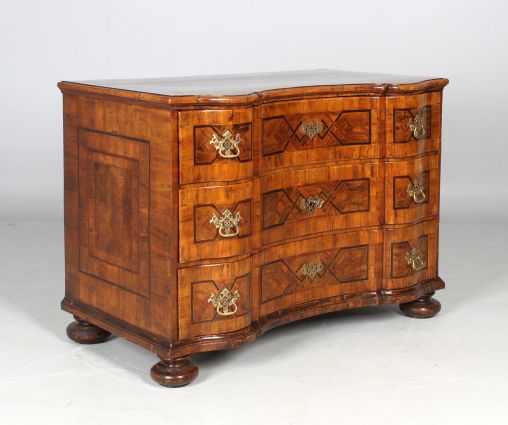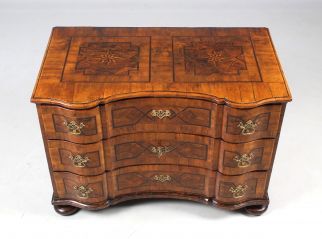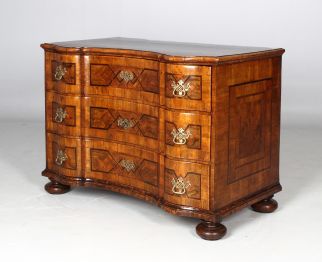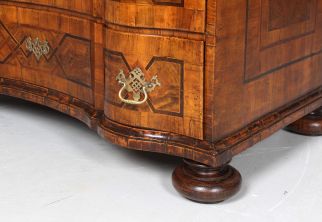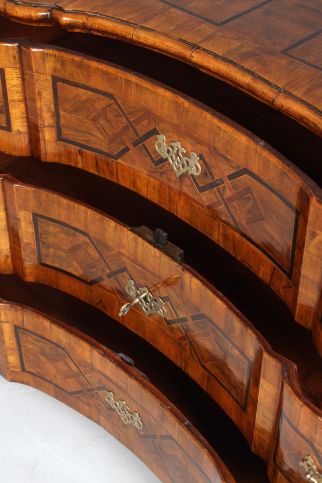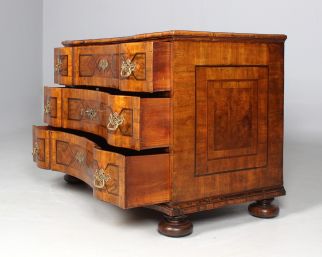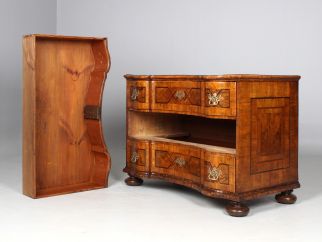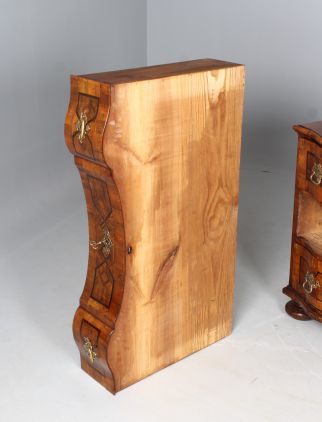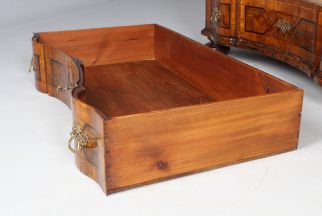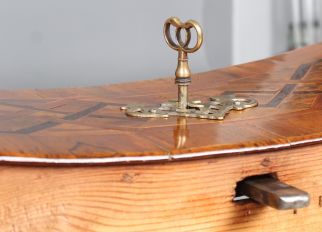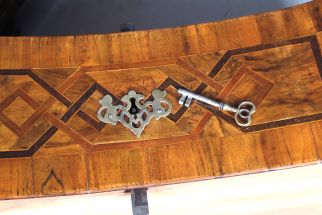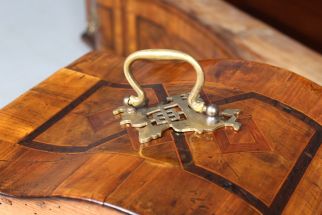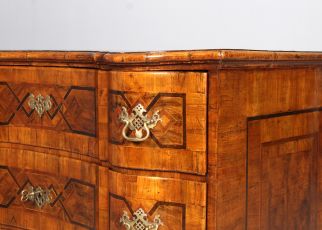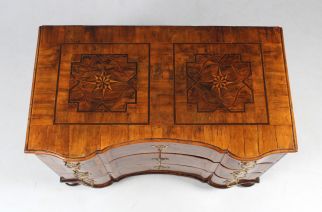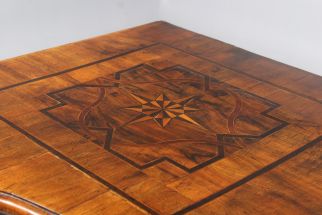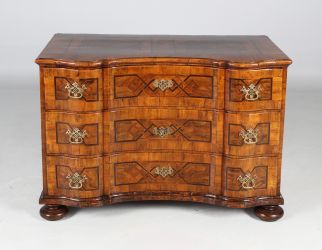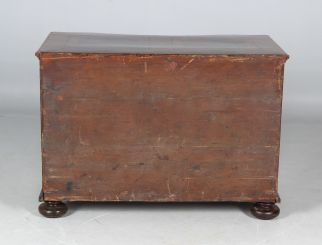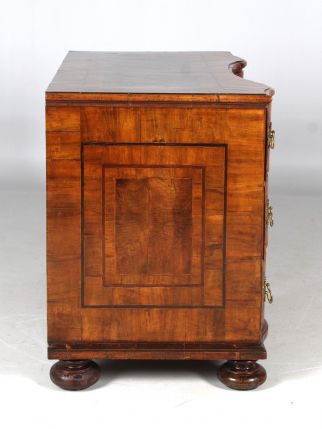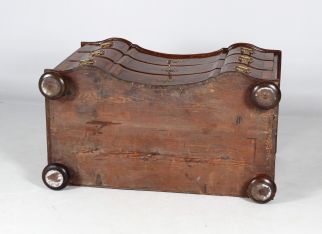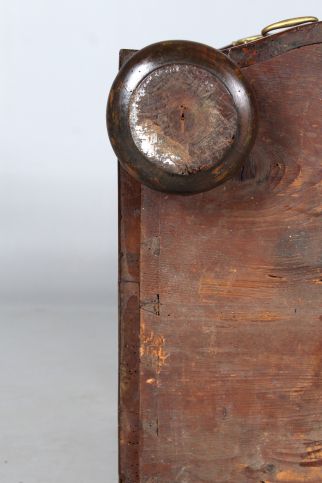Antique Baroque Commode with Patina
Southern Germany
Walnut a.o.
Middle 18th century
Dimensions: H x W x D: 87 x 123 x 69 cm
Description:
Three-drawer chest of drawers standing on pinch feet with a curved and creased front.
The drawers are divided into three sections each by the tails and also by the strictly geometric marquetry in plum wood and bog oak, each framed by maple threads.
The sides of the chest of drawers are also divided by inlays, here in a simpler version.
The top panel is also interesting with its dominant folding stars in light and dark contrasting woods. The surrounding inlay work is executed in a similar style to the front of the furniture.
The fittings correspond to the time when the furniture was made, but were added later. The large box lock in the centre drawer, which closes upwards and downwards and thus locks all three drawers, is original and absolutely impressive.
A similar piece of furniture is known from Seehof Castle near Bamberg.
Condition:
Piece of furniture restored with patina preserved. The original appearance has been preserved and the piece of furniture is well prepared for the decades to come.
Loosened veneers have been glued down and stabilised. The existing shellac polish was gently cleaned and refreshed. The drawers run cleanly and smoothly, the lock works perfectly. There are numerous preserved signs of age and use, please take a look at the detailed photos.
Personal note:
The question of the right degree of restoration, of preserving what is worth preserving, of conserving or removing signs of age and wear is one that divides the antiques industry time and again.
While some people like their finely restored pieces of furniture that are in top condition and function perfectly, others love the charm of what has been used and interpret signs of wear as an important feature of antiques and as a sign of age and authenticity.
But who wants to presume to decide which patina condition is exactly the right one? Shouldn't everyone decide for themselves, according to their own personal taste?
There is no generally binding definition of patina for the antiques trade and the judgement as to whether patina is still present or has already decayed is absolutely subjective. The degree of patina that is worth preserving should be decided by the person who owns the piece of furniture, who lives with it or who, like me, trades in old pieces of furniture. As long as a piece of furniture is loved and lived with, it has a right to exist. Whether with patina or without.
An antique piece of furniture was only truly original when it left its maker's workshop 100, 200 or even more years ago. And at that time it was definitely without patina.
From that point onwards, the patina began to grow. The furniture was used, drawers were opened and closed, doors were banged, table tops were wiped again and again. And that over decades. Over all these years, not only tensile, compressive and frictional forces had an effect, but also temperature fluctuations, changes in humidity and sunlight. Leather surfaces and fire gilding wore away, veneers came loose and all wood moved with the rhythm of the seasons.
My personal opinion is that every scratch, every discolouration and every imperfection tells its own story and bears witness to beautiful and less beautiful decades.
Signs of age and wear shape the character of a piece of furniture and give it a certain charm. They always encourage you to realise how old the piece of furniture is and what it has already experienced.
The condition of a decades-old patina only exists once. Once the patina has been "restored away", it remains "restored away".
It then has to be created from scratch, because you can't create a real patina with any stain in the world - a real patina takes time. It has to grow and flourish over decades and centuries.
Article found under: Chests of drawers
Also interesting
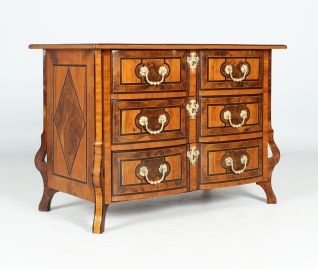
Antique chest of drawers - so-called Commode Mazarine
France
Walnut, olive, burl wood
first half of 18th century.
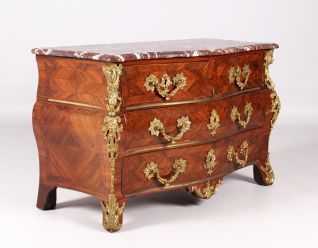
Impressive Louis XV chest of drawers
France (Paris)
Rosewood
Louis XV around 1730
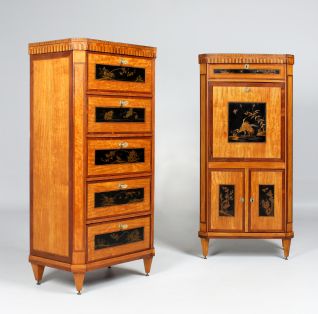
Pair of antique chinoiserie furniture
The Netherlands
Satinwood and others, lacquered panels
around 1890
